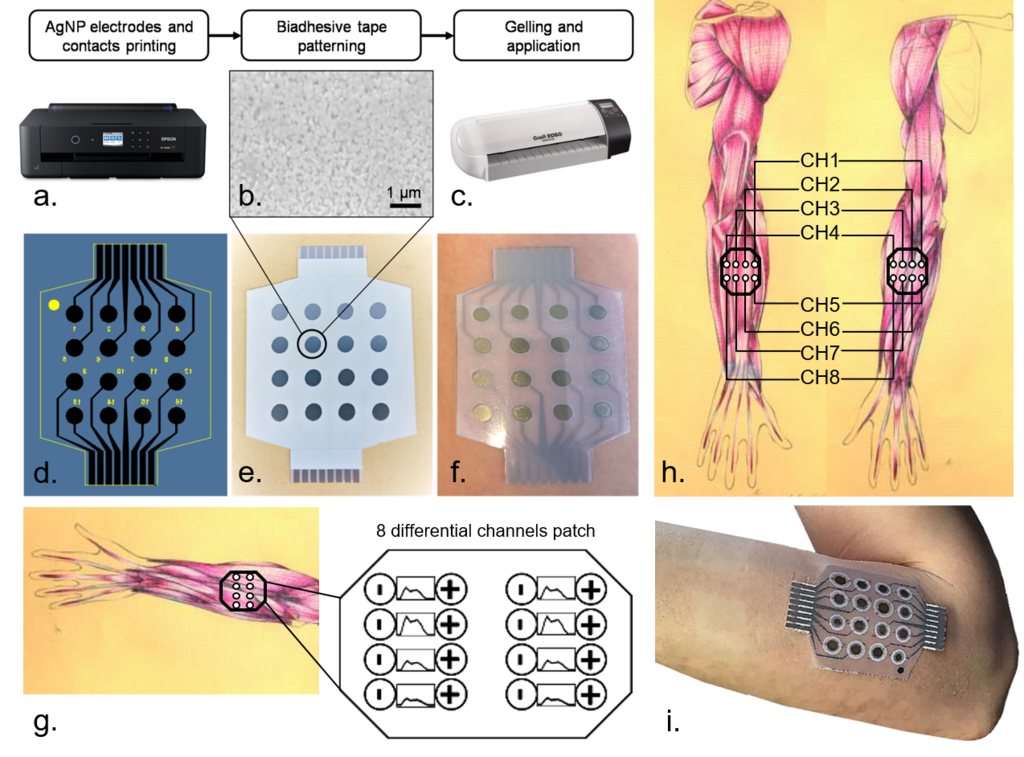
Printable sensors for a patient-oriented approach
Surface electromyography (sEMG) is the standard, non-invasive approach to investigating muscular activity: two electrodes placed on the skin measure the difference in voltage between two positions over the muscle under examination, allowing muscular activity to be recorded during any motor activity, such as grasping an object, moving a limb and even walking.
That is why sEMG is widely used in the control of robotic prostheses as a muscle-computer interface for the control of neurorehabilitation devices: in this context, gesture recognition based on sEMG aimed at classifying human gestures through mathematical algorithms plays an important role.
The Department of Information Engineering of the University of Padova (Dr. Giulia Cisotto, Dr. Giulio Rosati, and Prof. Alessandro Paccagnella), in collaboration with BrainTrends, has developed low-cost, easy-to-use, customized sensors that can be quickly produced using inkjet printing to acquire and analyze sEMG signals. The clinical proof-of-concept was then carried out at the IRCCS Santa Lucia's Laboratory of Neuroscience and Applied Technologies, by a team of researchers coordinated by Prof. Viviana Betti of the Department of Psychology of Sapienza University. The results were published in the scientific journal Scientific Reports.
The sensors were produced with silver nanoparticle (AgNP) inks, which are widely used for rapid prototyping of sEMG electrodes. Compared to nanomaterials used in recent years, such as graphene, silver nanowires and carbon nanotubes, which show significant limitations such as the lack of reproducibility, limited conductivity, instability and usually high costs, commercial AgNP inks are much more stable and reproducible, providing better performance. In addition, these sensors can be designed in a completely customized way, depending on the application and the end user's needs.
To date, the use of surface electromyography in neuroscience to measure EMG signals in everyday life scenarios has been limited due to complex manufacturing procedures, expensive materials and the need for considerable operator training. In contrast, this research proposes a complete paradigm shift in the prototyping and production of printable sEMG sensors: it introduces an ultra-fast, low-cost, print-and-play fabrication technology that can be used by any laboratory for customizable electrophysiological measurement systems, even without specific expertise. The idea is to provide clinicians with a manufacturing platform consisting of easy-to-use tools. To this end, the research team has optimized each step of the manufacturing process to keep costs down, and all the necessary materials are commercially available.
"We designed 8-channel sEMG matrices to measure forearm muscle activity, using innovative silver nanoparticle-based inks to print the sensors directly embedded in each array, with a commercial inkjet printer. We then acquired multi-channel sEMG data from the 12 participants while they repeatedly performed 12 standard finger movements, six extensions and six flexions", says prof. Viviana Betti of Sapienza University.
The sensors recorded a high degree of similarity in the values between different repetitions of the same gesture for each participant and a significant difference between different movements.
When comparing various predictive models, a good level of overall classification accuracy emerged in the recognition of specific hand finger gestures (93-95%) both for flexion and extension.
"Finally," continues Betti, "if we use FEM simulations (finite element method), we could also obtain further customizations of the sEMG acquisition, to adapt it to different purposes: making it, for example, less intrusive in continuous monitoring in daily life, or with a denser configuration for very fine clinical tests, during motor training."
In contrast to many other human-machine interfaces, which have been shown to have good signal transduction and appropriate and accurate classifications, EMG signal transduction remains a critical issue, particularly for applications requiring customized electrode geometries to suit specific patient needs.
This work contributes to developing new and low-cost tools that allow us to evolve towards wearable, scalable and customizable applications. The ultimate goal is to help patients and healthcare professionals improve clinical practice and neurorehabilitation with an increasingly personalized approach to the patient.
References:
Inkjet-printed fully customizable and low-cost electrodes matrix for gesture recognition- Giulio Rosati, Giulia Cisotto, Daniele Sili, Luca Compagnucci, Chiara De Giorgi, Enea Francesco Pavone, Alessandro Paccagnella, Viviana Betti. Scientific Reports 2021 DOI: https://doi.org/10.1038/s41598-021-94526-5
Further Information
Viviana Betti
Department of Psychology
viviana.betti@uniroma1.it



